
views
X
Trustworthy Source
Cleveland Clinic
Educational website from one of the world's leading hospitals
Go to source
To insert an IV, you should first become a trained medical professional. Prepare to insert the IV, access the vein, and maintain the IV for the best results.
Preparing to Start an IV

Gather your materials. Though starting an IV isn't nearly as serious of an undertaking as more complicated procedures, it still requires the same basic level of preparation and precaution as any minor medical procedure. Before you begin, you'll want to have all of the tools and equipment you need handy and you'll want to be sure that any materials which will come into contact with the patient's body — especially your needles — are fresh and sterile. To start a typical IV line, you will need: Sterile disposable gloves Appropriate size "over-the-needle" IV catheter (typically 14 - 25 gauge) Bag of IV fluid Non-latex tourniquet Sterile bandage or dressing Gauze Alcohol wipes Medical tape Sharps container Sterile pad or paper (set small tools out on this to keep them close at hand)

Introduce yourself to the patient. An important part of the process of starting an IV is introducing yourself to the patient and explaining the procedure that's about to occur. Talking to patients and sharing this basic information helps put them at ease and ensures that no part of the process surprises or shocks them. In addition, it ensures that you have their full consent to proceed. When you're done, have the patient lay or recline where they'll be receiving their IV. When patients are nervous, their veins may contract somewhat in a process called vasoconstriction. This makes it harder to start an IV, so make sure your patient is as relaxed and comfortable as possible before proceeding. You may want to ask whether the patient has had any trouble with IVs in the past. If so, the patient may be able to tell you which sites are easiest to access.

Prepare the IV tubing. Next, prime the IV tubing by suspending the IV bag from an elevated stand, filling the tubing with saline solution, and checking for any bubbles. If necessary, clamp the tubing so that the solution doesn't drip onto the floor. Be sure to remove any bubbles from the tubing by gently tapping, squeezing, or flushing them out of the line. A dated and signed sticker should then be placed on both the IV tubing and the IV bag. Injecting air bubbles into a patient's bloodstream can cause a serious condition called an embolism. One easy technique for removing bubbles from the IV tubing is to uncoil the tubing to its full length and run the roller valve all the way up to the drip chamber. Next, puncture the IV bag with the tubing spike and pinch the drip chamber. Open the roller valve and release the line — fluid should flow down the length of the tubing without producing any bubbles.
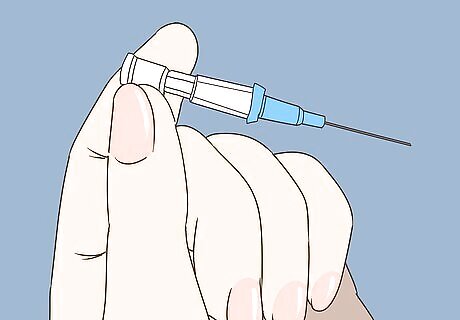
Choose a suitable-gauge catheter for the situation. Typically, IV catheters are mounted over the needle used to puncture the vein. After the vein is accessed, the catheter is left in place for easy access to the vein. Catheters come in different sizes called gauges. The smaller the gauge number, the thicker the catheter and the more rapidly medicine can be administered and blood can be drawn. However, thick catheters are also cause more painful insertion, so it's important not to use a catheter that's bigger than you need. In general, for IVs, you'll need a catheter that's about 14-25 gauge. Tend towards higher-gauge (thinner) catheters for children and the elderly, but tend towards lower-gauge (thicker) catheters when rapid transfusion is needed.

Put on clean gloves. Inserting an IV pierces the skin and introduces foreign equipment directly into the bloodstream. To avoid the risk of a dangerous infection, it's important to wash your hands and dry them with a clean paper towel before beginning, then put on clean gloves before you handle your equipment and touch the patient. If at any point your gloves' sterility becomes compromised, take them off and put on a new pair; it's better to be safe than sorry. Below are situations where most medical standards require changing gloves: Before touching the patient Before clean/aseptic procedures (like administering IV medications) After procedures with a risk of body fluid exposure After touching the patient After touching the patient's surroundings Before moving to a different patient
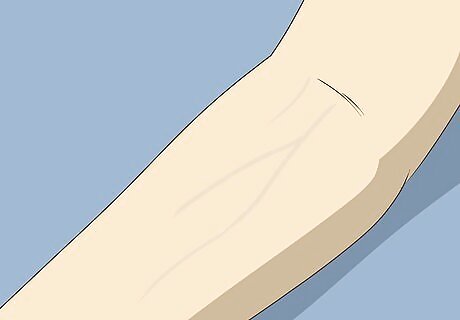
Look for prominent veins. Next, you'll want to find a site on the patient to administer the IV. For adult patients, the most accessible veins are long, straight ones in upper extremities that aren’t near joints and are furthest from the body. For children, the scalp, hand, or foot is more preferable as an IV site than a leg, arm or elbow fold. While any accessible vein can be used to start an IV, it’s best to avoid veins in the patient’s dominant hand. If your patient has a history of hard-to-reach veins, ask where doctors have previously had success. Usually, patients with previous difficult IV experiences will know where their veins are most accessible. Note that, regardless of the presence of veins, there are certain places you won't want to insert an IV. These include: Places where the IV will interfere with surgery In the same location as another recent IV In a site that shows signs of infection (redness, swelling, irritation, etc.) In a limb on the same side of the body as a mastectomy or vascular graft (this can lead to complications)
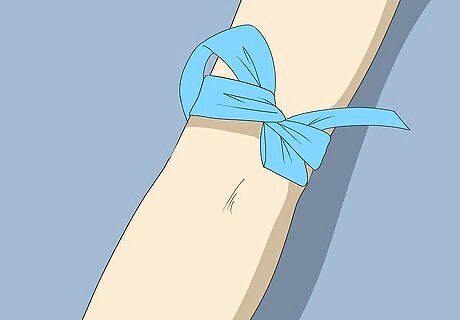
Apply a tourniquet. To get your chosen veins to swell up for easy insertion, apply a tourniquet behind (in the direction of the torso) the intended IV site. For instance, if you're going to insert the IV into the typical site of the underside of the forearm, you might put the tourniquet part of the way up the upper arm. Don't tie the tourniquet too tight — this can cause bruising, especially in the elderly. It should be tight, but not so tight that you can't slip a finger underneath. Letting the limb hang limp towards the floor while a tourniquet is in place can help the veins become more prominent by increasing the blood flow to the limb.
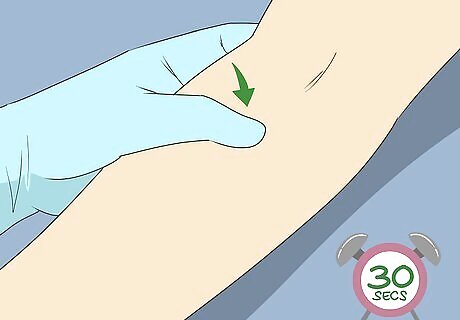
Palpate the vein if necessary. If you're having a hard time finding suitable veins, it can be helpful to palpate the patient's skin in the area of the IV site. Align your finger in the direction of the vein, then press down on the skin above it. You should feel the vein "push back". Continue pressing with a bouncing motion for about 20-30 seconds.The vein should become visibly larger.
Accessing the Vein
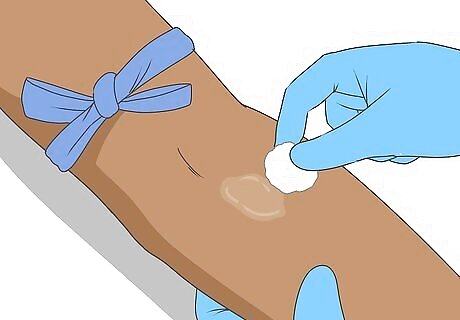
Disinfect the IV site. Next, tear open a fresh alcohol wipe (or use a similar sterilising method like chlorhexidine) and apply it to the skin in the area that the IV will be inserted. Wipe gently but thoroughly, ensuring an even coat of alcohol. This kills bacteria on the skin, minimizing the chance of infection when the skin is punctured.
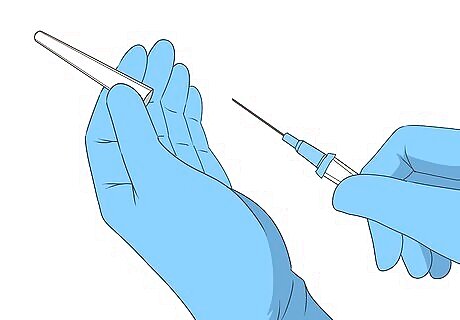
Prepare the catheter for insertion. Remove the catheter from its sterile packaging. Briefly inspect it to ensure that it is intact and working. Press down on the flashback chamber to ensure it is tight. Spin the catheter hub to ensure it sits loosely on the needle. Remove the protective cap and inspect the needle, taking care to ensure the needle doesn't touch anything. If everything looks in order, prepare to insert the needle. Don't allow the catheter or needle to come into contact with anything other than the patient's skin in the IV site. This can compromise their sterility and increase the risk of infection.
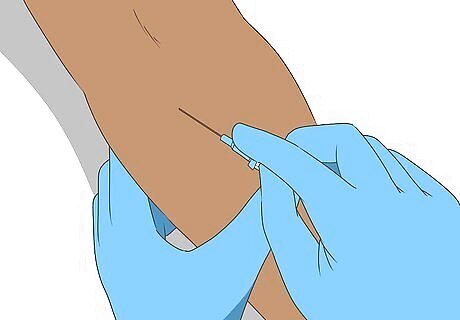
Insert the needle. Use the non-dominant hand to stabilise the patient's limb with gentle pressure, taking care not to touch the IV site directly. Take the catheter in your dominant hand and insert the needle (bevel facing up) through the skin. Reduce the angle of insertion as you advance the needle into the vein — use a shallow-angled approach. Look for a flashback of blood at the catheter hub. This is a sign that you've successfully hit the vein. Once you see the flashback, advance the needle one more centimeter (cm) into the vein.

If you miss the vein, explain and try again. Inserting an IV is a delicate art — sometimes, even experienced doctors and nurses miss the vein on their first attempt, especially if the patient has difficult-to-hit veins. If you advance the needle and don't see a flashback of blood, explain to the patient that you've missed and are going to try again. Try to be pleasant to the patient — this process can be painful. If you repeatedly miss the vein, apologize to the patient, remove the needle and catheter, and try again on a different limb with a fresh needle and catheter. Attempting numerous inserts on the same vein can be very painful for the patient and leave lasting bruising. You might comfort the patient by explaining why it didn’t work and also saying something like, “Sometimes these things just happen. It’s no one’s fault. We should get it right next time.”
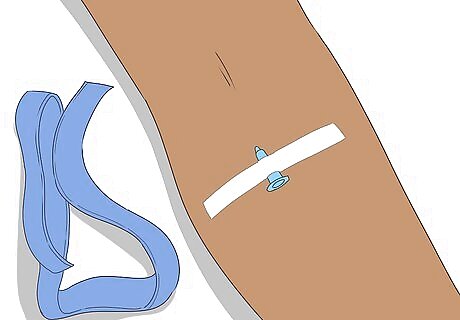
Remove and discard the needle. Maintaining pressure on the skin, pull the needle (only the needle — not the catheter) about 1 centimeter (0.4 in) back out of the vein. Slowly advance the catheter into the vein while maintaining pressure on the vein and skin. When the cannula is seated in the vein, remove the tourniquet and secure the catheter by placing a sterile bandage or dressing (like Tegaderm) over the lower half of the catheter hub. Be sure not to block the the IV tubing connection with your dressing.
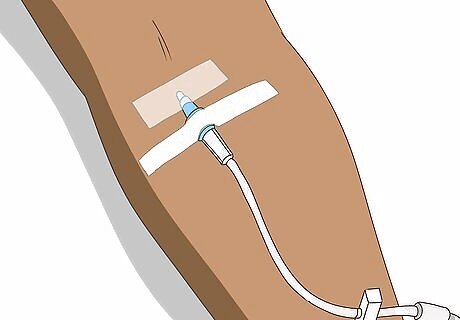
Remove the needle and insert the tubing. Hold onto the catheter hub with your thumb and index finger. Keep it securely seated in the vein. Using your other hand, carefully pull the needle (and only the needle) out of the vein. Dispose of the needle in a proper sharps container. Next, remove the protective cover from the end of the primed IV tubing and carefully insert it into the catheter hub. Secure it in the catheter by screwing and locking in place.

Secure the IV. Finally, secure the IV against the patient's skin. Place a piece of tape over the catheter hub, then make a loop in the catheter tubing and tape this down with a second piece of tape over the first. Place a clear dressing over IV site, leaving the catheter hub exposed. Secure the other end of the loop above the site of the IV with a third piece of tape. Putting loops in the tubing reduces the strain on the IV catheter, making it more comfortable for the patient and less likely to accidentally be removed from the vein. Make sure there are no kinks in the loop — this can interfere with the flow of fluids into the bloodstream. Don’t forget to place a label with the date and time of insertion on the IV dressing.
Maintaining an IV

Check the flow of fluid into the IV. Open the IV roller clamp and look for drips forming in the drip chamber. Check that the IV is infusing into the vein by occluding the vein (pressing down on it to block its flow) distal to the site of the IV (away from the torso). The flow of drips should slow and stop, then restart flowing when you stop occluding the vein.
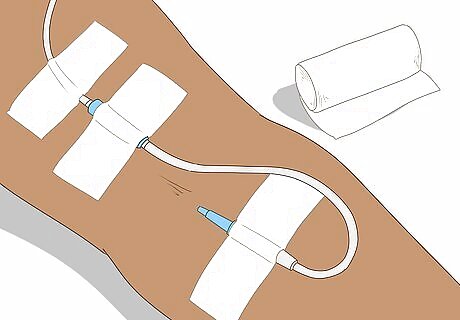
Change the dressing as needed. IVs left in for an extended period of time are at a greater risk of infection than IVs used only for a single operation or procedure. To reduce the risk of infection, it's important to carefully remove the dressing, clean the site of the IV, and put a new dressing in place. In general, transparent dressings should be changed roughly weekly, while gauze dressings should be changed more frequently because they don't allow observation of the IV site. Don't forget to wash your hands and wear a fresh pair of gloves every time you touch a patient's IV site. This is especially important for when you're changing dressings, as the use of long-term IV connections is associated with an increased rate of infection. Overcome insertion difficulties. "When I first started as a nurse, I couldn't hit a vein to save my life. After a few patients with bruises up and down their arms, I decided to buckle down with this guide. Looking at those pictures and steps made it all click — I could see exactly what I was doing wrong. Now, my coworkers ask for tips when they have trouble inserting an IV!" - Breeaunna W. Maintain IVs properly to avoid complications. "My dad was diagnosed with heart failure last year. The doctors wanted him on IV medications at home to help manage it. I'll admit, I was nervous about handling his IVs day after day. But this article explained why changing dressings and keeping everything sterile is so important to avoid infection. Thanks to that critical advice, Dad hasn't had any issues or complications from his home IVs after a whole year." - Shivanand R. Prepare loved ones for weekly infusions. "As my grandpa's caretaker, I had to learn to handle his weekly treatments when insurance stopped covering home nurses. I'll admit poking IV needles into my 80-year-old grandpa made me nervous at first. But the step-by-step instructions and pictures in this guide made me confident I could learn the proper technique. Now, administering the infusions is like second nature. My grandpa actually finds it comforting when his familiar granddaughter handles everything instead of rotating nurses. This guide made a scary situation so much smoother for both of us." - Lexi B. Did you know that wikiHow has collected over 365,000 reader stories since it started in 2005? We’d love to hear from you! Share your story here.
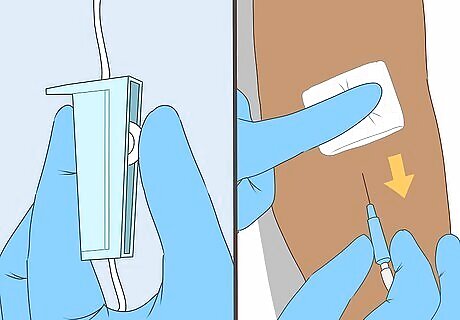
Remove the IV safely. To remove an IV, first, close the roller clamp to stop the flow of fluid. Gently remove the tape and dressing to expose the catheter hub and IV site. Place a clean piece of gauze over the IV site and apply delicate pressure as you pull the catheter out, slowly. Secure the gauze over the puncture site with tape or a bandage, such as Coban.
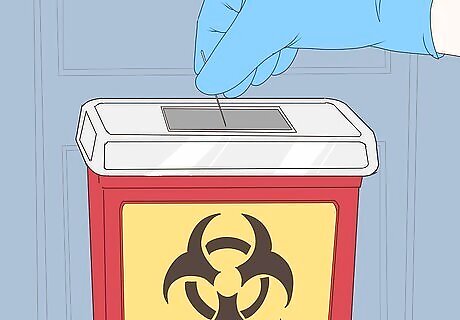
Dispose of all needles properly. The needles used to start an IV qualify as medical sharps and need to placed in a well-marked sharps container immediately after use. Because needles can transfer infectious agents and even blood-borne illnesses from person to person if handled improperly, it's extremely important to ensure that these needles aren't disposed with ordinary trash, even if you're sure that the patient is perfectly healthy.
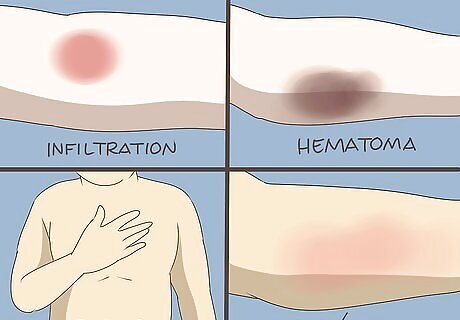
Know IV-related complications. Though IVs are usually safe procedures, there is always a very small but real chance that complications will result from the IV. It's important to know the most common signs of IV complications to be able to provide the best care to the patient and, if need, to know when to get emergency care. Some IV complications (and their symptoms are below: Infiltration: Occurs when fluid is injected outside of the vein into surrounding soft tissue. Will cause swelling and smooth, pale skin in the affected area. Can be a minor or serious issue depending on the medicine being administered. Hematoma: Occurs when blood leaks from the vein into the surrounding tissue, usually after more than one vein wall is accidentally punctured. Often accompanied by pain, bruising, and irritation. Will usually resolve within several weeks light pressure. Embolism: Occurs after injecting air into the vein. Often caused by air bubbles in the IV tubing. Children are especially at risk. In serious cases, causes trouble breathing, chest pain, blue skin, low blood pressure, and even stroke and heart attack. Thrombosis and endarteritis: Life-threatening conditions that can result from injecting into an artery, rather than a vein. Can lead to severe pain, compartment syndrome (high pressure on a muscle leading to a very painful "tight" or "full" feeling) gangrene, motor dysfunction, and even the eventual loss of the limb.













Comments
0 comment